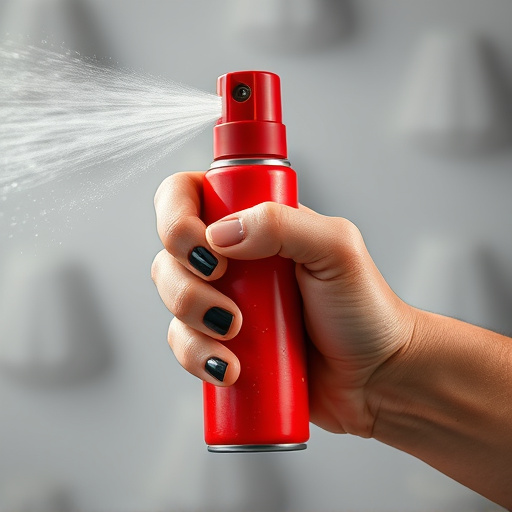OC spray, using capsaicin from chili peppers, is a popular civilian self-defense tool with concentration levels typically 1%-2% for temporary incapacitation without permanent harm. Understanding capsaicin concentration and local legal frameworks is crucial when considering OC spray for protection. Proper training, safe handling, and adherence to laws ensure responsible use.
“In today’s unpredictable world, civilians increasingly seek effective self-defense options. One tool gaining popularity is OC spray, also known as pepper spray, offering a non-lethal means of protection. This article delves into the world of OC spray, exploring its role in civilian defense. We’ll dissect the active ingredient, capsaicin concentration levels, and provide essential guidelines for safe use. Additionally, we’ll navigate legal considerations surrounding these self-defense sprays, ensuring informed decisions.”
- OC Spray: A Civilian Self-Defense Tool
- Understanding Capsaicin Concentration in OC Spray
- Safety and Effective Use Guidelines for OC Spray
- Legal Considerations for Civil Protection Spray
OC Spray: A Civilian Self-Defense Tool
OC spray, also known as pepper spray, has emerged as a popular self-defense tool for civilians. Its primary active ingredient is capsaicin, a chemical derived from chili peppers that stimulates pain receptors in the eyes and respiratory system. The capsaicin concentration levels in OC spray vary, typically ranging from 1% to 2%, ensuring its effectiveness without causing permanent harm. This makes it a relatively safe option for individuals looking to protect themselves against potential threats.
Civilian use of OC spray offers several advantages. It’s non-lethal, allowing users to incapacitate an attacker long enough to escape or call for help. The spray is easy to carry and can be deployed quickly in various situations, from personal safety to crowd control. Moreover, with proper training, individuals can learn how to maximize its effectiveness while minimizing the impact on bystanders.
Understanding Capsaicin Concentration in OC Spray
One crucial aspect to consider when evaluating OC spray for civilian protection is understanding its capsacin concentration levels. OC spray, short for Oleoresin Capsicum spray, is a non-lethal self-defense tool that works by irritating the eyes and respiratory system using capsaicin, the chemical responsible for the heat sensation in chili peppers. The concentration of capsicin in OC spray varies widely, typically measured in milligrams per milliliter (mg/mL).
Different levels of capsacin offer varying degrees of protection and effectiveness. Lower concentrations, often around 1-2% capsicin, provide a mild irritation suitable for crowd control or less aggressive self-defense scenarios. Higher concentrations, ranging from 5% to 10%, are designed for more intense situations, offering better immobilizing effects but also increasing the risk of temporary blindness and severe respiratory distress. When choosing OC spray for civilian use, it’s essential to balance the desired level of protection with the potential impact on individuals caught in the crossfire.
Safety and Effective Use Guidelines for OC Spray
Using OC spray, also known as pepper spray, requires careful consideration and adherence to safety guidelines for effective civilian protection. It’s important to understand that OC spray utilizes capsaicin, a compound derived from chili peppers, to incapacitate an aggressor temporarily. The active ingredient comes in different concentration levels; typically measured in percent or milliliters per can. For civilian use, lower concentrations like 1% and 2% are recommended for balance between effectiveness and safety.
Proper handling involves aiming carefully at the face of an assailant, maintaining a safe distance to avoid cross-contamination. Users should be trained on correct spray techniques, including how to activate the device and ensure proper distribution of the spray. After use, thorough washing of skin and clothing is crucial. OC spray can cause temporary discomfort and irritation; therefore, users must also be prepared for these side effects. Regular practice and adherence to safety protocols are essential to ensure responsible and effective use in real-life situations.
Legal Considerations for Civil Protection Spray
When considering an inflammatory spray for civilian protection, it’s crucial to understand the legal considerations that govern its use. The legality of such self-defense tools varies significantly across jurisdictions, with each country and state having its own set of regulations. One key factor is the OC Spray Capsaicin Concentration Levels, which refer to the strength of the capsaicin (the active ingredient in oleoresin capsicum spray) contained within the device. Higher concentrations offer greater stop-and-disabilitate capabilities but may also increase the risk of harm if not used responsibly.
Additionally, the legal framework around civil protection sprays often includes provisions on who can purchase and carry them, as well as where and under what circumstances they can be deployed. Users must ensure they are acting within the bounds of the law to avoid facing charges such as assault or reckless endangerment. Understanding local legislation is essential for responsible self-defense, ensuring that individuals protect themselves and their loved ones without crossing legal lines.
OC spray, with its capsaicin concentration levels varying from 1% to 2%, offers civilians a powerful yet safe self-defense tool. Understanding the active ingredient and adhering to safety guidelines is crucial for effective use. When deployed responsibly, OC spray can provide much-needed protection without causing severe harm. Always stay informed about local legal considerations regarding civilian protection sprays to ensure compliance while safeguarding yourself and others.
